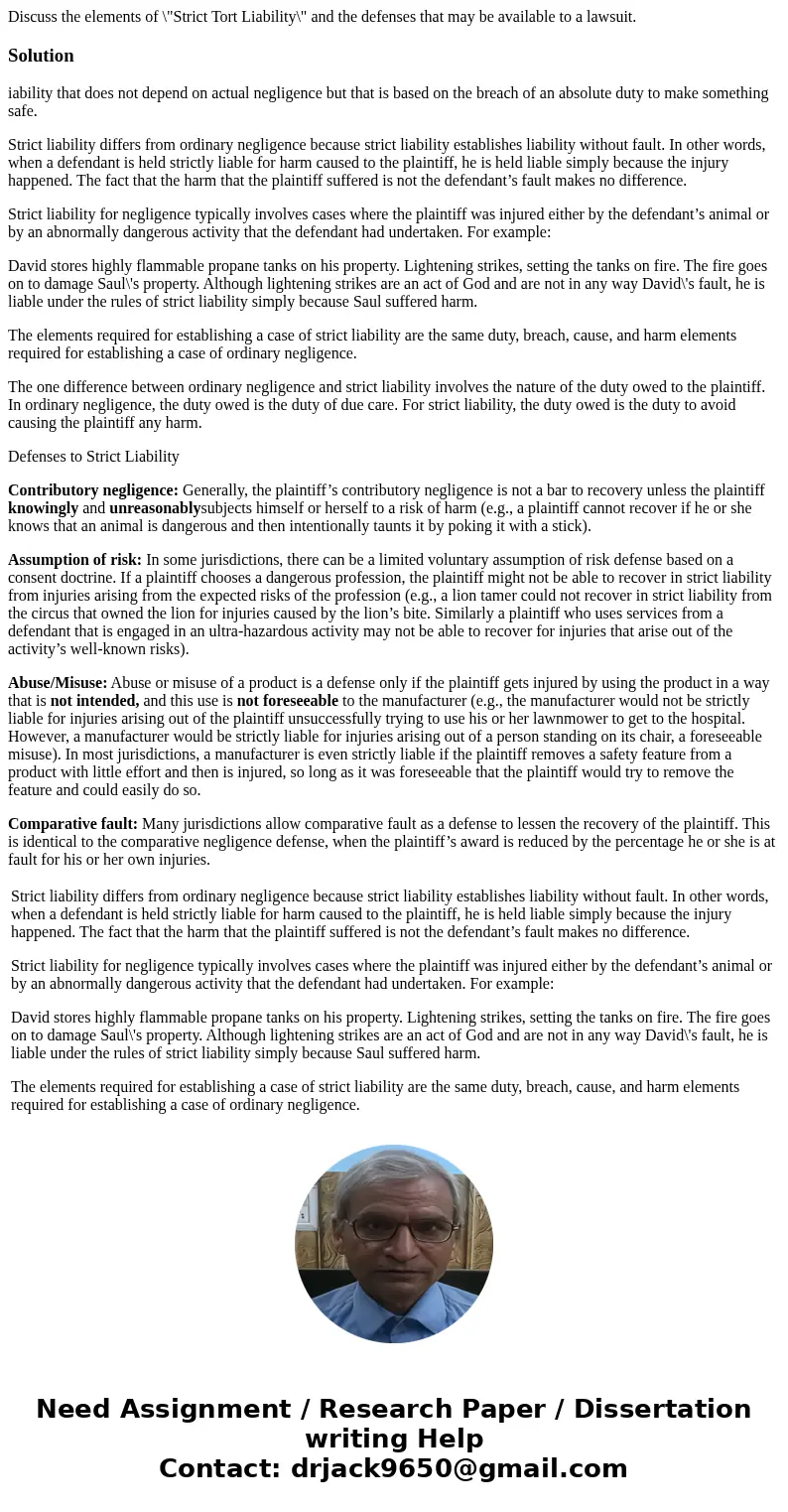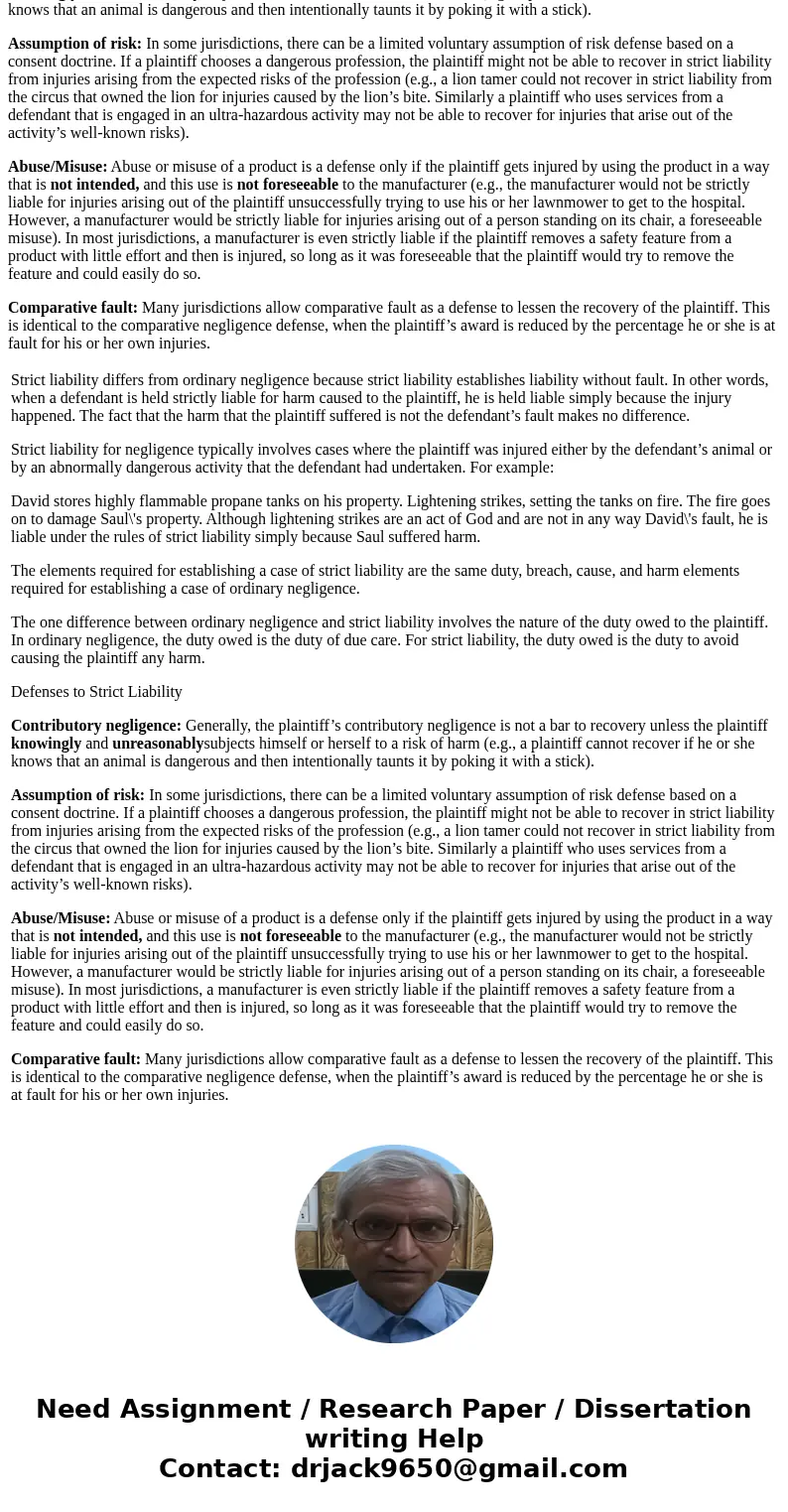Discuss the elements of Strict Tort Liability and the defens
Discuss the elements of \"Strict Tort Liability\" and the defenses that may be available to a lawsuit.
Solution
iability that does not depend on actual negligence but that is based on the breach of an absolute duty to make something safe.
Strict liability differs from ordinary negligence because strict liability establishes liability without fault. In other words, when a defendant is held strictly liable for harm caused to the plaintiff, he is held liable simply because the injury happened. The fact that the harm that the plaintiff suffered is not the defendant’s fault makes no difference.
Strict liability for negligence typically involves cases where the plaintiff was injured either by the defendant’s animal or by an abnormally dangerous activity that the defendant had undertaken. For example:
David stores highly flammable propane tanks on his property. Lightening strikes, setting the tanks on fire. The fire goes on to damage Saul\'s property. Although lightening strikes are an act of God and are not in any way David\'s fault, he is liable under the rules of strict liability simply because Saul suffered harm.
The elements required for establishing a case of strict liability are the same duty, breach, cause, and harm elements required for establishing a case of ordinary negligence.
The one difference between ordinary negligence and strict liability involves the nature of the duty owed to the plaintiff. In ordinary negligence, the duty owed is the duty of due care. For strict liability, the duty owed is the duty to avoid causing the plaintiff any harm.
Defenses to Strict Liability
Contributory negligence: Generally, the plaintiff’s contributory negligence is not a bar to recovery unless the plaintiff knowingly and unreasonablysubjects himself or herself to a risk of harm (e.g., a plaintiff cannot recover if he or she knows that an animal is dangerous and then intentionally taunts it by poking it with a stick).
Assumption of risk: In some jurisdictions, there can be a limited voluntary assumption of risk defense based on a consent doctrine. If a plaintiff chooses a dangerous profession, the plaintiff might not be able to recover in strict liability from injuries arising from the expected risks of the profession (e.g., a lion tamer could not recover in strict liability from the circus that owned the lion for injuries caused by the lion’s bite. Similarly a plaintiff who uses services from a defendant that is engaged in an ultra-hazardous activity may not be able to recover for injuries that arise out of the activity’s well-known risks).
Abuse/Misuse: Abuse or misuse of a product is a defense only if the plaintiff gets injured by using the product in a way that is not intended, and this use is not foreseeable to the manufacturer (e.g., the manufacturer would not be strictly liable for injuries arising out of the plaintiff unsuccessfully trying to use his or her lawnmower to get to the hospital. However, a manufacturer would be strictly liable for injuries arising out of a person standing on its chair, a foreseeable misuse). In most jurisdictions, a manufacturer is even strictly liable if the plaintiff removes a safety feature from a product with little effort and then is injured, so long as it was foreseeable that the plaintiff would try to remove the feature and could easily do so.
Comparative fault: Many jurisdictions allow comparative fault as a defense to lessen the recovery of the plaintiff. This is identical to the comparative negligence defense, when the plaintiff’s award is reduced by the percentage he or she is at fault for his or her own injuries.
| Strict liability differs from ordinary negligence because strict liability establishes liability without fault. In other words, when a defendant is held strictly liable for harm caused to the plaintiff, he is held liable simply because the injury happened. The fact that the harm that the plaintiff suffered is not the defendant’s fault makes no difference. Strict liability for negligence typically involves cases where the plaintiff was injured either by the defendant’s animal or by an abnormally dangerous activity that the defendant had undertaken. For example: David stores highly flammable propane tanks on his property. Lightening strikes, setting the tanks on fire. The fire goes on to damage Saul\'s property. Although lightening strikes are an act of God and are not in any way David\'s fault, he is liable under the rules of strict liability simply because Saul suffered harm. The elements required for establishing a case of strict liability are the same duty, breach, cause, and harm elements required for establishing a case of ordinary negligence. The one difference between ordinary negligence and strict liability involves the nature of the duty owed to the plaintiff. In ordinary negligence, the duty owed is the duty of due care. For strict liability, the duty owed is the duty to avoid causing the plaintiff any harm. Defenses to Strict Liability Contributory negligence: Generally, the plaintiff’s contributory negligence is not a bar to recovery unless the plaintiff knowingly and unreasonablysubjects himself or herself to a risk of harm (e.g., a plaintiff cannot recover if he or she knows that an animal is dangerous and then intentionally taunts it by poking it with a stick). Assumption of risk: In some jurisdictions, there can be a limited voluntary assumption of risk defense based on a consent doctrine. If a plaintiff chooses a dangerous profession, the plaintiff might not be able to recover in strict liability from injuries arising from the expected risks of the profession (e.g., a lion tamer could not recover in strict liability from the circus that owned the lion for injuries caused by the lion’s bite. Similarly a plaintiff who uses services from a defendant that is engaged in an ultra-hazardous activity may not be able to recover for injuries that arise out of the activity’s well-known risks). Abuse/Misuse: Abuse or misuse of a product is a defense only if the plaintiff gets injured by using the product in a way that is not intended, and this use is not foreseeable to the manufacturer (e.g., the manufacturer would not be strictly liable for injuries arising out of the plaintiff unsuccessfully trying to use his or her lawnmower to get to the hospital. However, a manufacturer would be strictly liable for injuries arising out of a person standing on its chair, a foreseeable misuse). In most jurisdictions, a manufacturer is even strictly liable if the plaintiff removes a safety feature from a product with little effort and then is injured, so long as it was foreseeable that the plaintiff would try to remove the feature and could easily do so. Comparative fault: Many jurisdictions allow comparative fault as a defense to lessen the recovery of the plaintiff. This is identical to the comparative negligence defense, when the plaintiff’s award is reduced by the percentage he or she is at fault for his or her own injuries. |


 Homework Sourse
Homework Sourse